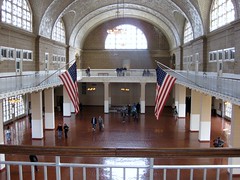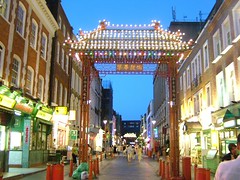| 216493674 | Push factor | A factor, such as unemployment, wide scale poverty in Kenya, or the lack of freedom of speech, that induces people to want to leave their country and move to another one (like the US), only hypothetically lol. |  | 0 |
| 205336528 | Migration | Form of relocation diffusion involving permanent move to a new location. |  | 1 |
| 216493675 | Pull factor | Positive conditions and perceptions that effectively attract people to new locales from other areas. |  | 2 |
| 205336529 | Emigration | migration from a place (especially migration from your native country in order to settle in another) | 3 | |
| 205336530 | Immigration | migration into a place (especially migration to a country of which you are not a native in order to settle there) | 4 | |
| 216493676 | Refugees | People who are forced to migrate from their home country and cannot return for fear of persecution because of their race, religion, nationality, membership in a social group, or political opinion. |  | 5 |
| 205336531 | Net migration | The difference between the number of immigrants and the number of emigrants | 6 | |
| 205336532 | net in-migration | If the number of immigrants exceeds the number of emigrants, the net migration is positive and the region has __________. | 7 | |
| 205336533 | net out-migration | If the number of emigrants exceeds the number of immigrants, then the net migration is negative and the region has __________. | 8 | |
| 216493677 | Mujahadeen | Afghan resistance group supplied with arms by the united states to assist in its fight against the soviets following their 1979 invasion of Afghanistan. Offset Soviet numbers and warriors by using Guerrilla tactics, aftermath of war left about 5 million refugees(the second largest in the world after the Palestinians. |  | 9 |
| 205336534 | Mobility | All types of movement from one location to another. | 10 | |
| 205336535 | Circulation | Short-term, repetitive, or cyclical movements that recur on a regular basis. | 11 | |
| 216493678 | Floodplain | The area subject to flooding during a given number of years according to historical trends. |  | 12 |
| 216493679 | Sahel | A strip of dry grasslands on the southern border of the Sahara; also known as "the shore of the desert" has become increasingly smaller and and large population growth in this very small region is now acting as a push factor. | 13 | |
| 216493680 | Dust Bowl | Parts of Oklahoma, Kansas, Colorado, New Mexico, and Texas that were hit hard by dry topsoil and high winds that created blinding dust storms; this area of the Great Plains became called that because winds blew away crops and farms, and blew dust from Oklahoma to Albany, New York. | 14 | |
| 216493681 | The Grapes of Wrath | John Steinbeck's classic novel which portrayed the migration of "Okies" to California during the Great Depression. , The story follows the fortunes of a poor family as they travel from the Dust Bowl region to California. |  | 15 |
| 216493682 | intervening obstacle | An environmental or cultural feature of the landscape that hinders migration. Were primarily environmental in the past, but modern transportation changed the dynamic and it is now more likely to be caused by local politics and government. | 16 | |
| 216493683 | E.G. Ravenstein | British demographer who sought an answer to "why people voluntarily migrate." He studied internal migration in England and proposed the laws of migration involving the use of Pull and Push factors. | 17 | |
| 216493684 | International migration | Permanent movement from one country to another. Divided into voluntary migration and forced migration. | 18 | |
| 216493685 | Internal migration | The permanent or semipermanent movement of individuals within a particular country. Divided into inter-regional migration and intraregional migration. | 19 | |
| 216493686 | Interregional migration | Permanent movement from one region of a country to another. A division of internal migration along with intraregional migration | 20 | |
| 216493687 | Intraregional migration | Permanent movement within one region of a country. A division of internal migration along with with Interregional migration | 21 | |
| 216493688 | Voluntary migration | Permanent movement(International migration) that has been undertaken by choice. |  | 22 |
| 216493689 | Forced migration | Permanent movement(International migration) compelled usually by cultural/political factors(Push factor). |  | 23 |
| 216493690 | Migration transition | Change in the migration pattern in a society that results from industrialization, population growth, and other social and economic changes that also produce the demographic transition. Proposed by Wilbur Zelinsky | 24 | |
| 216493691 | Wilbur Zelinsky | Geographer associated with migration transition--change in the migration pattern in a society that results from the social and economic changes that produce the demographic transition. Stage 2--international. Stage 3&4--internal | 25 | |
| 216493692 | Peaks of Euro Migration to America | 1st Peak -(1607-1840) 90% of immigrants were from Great Britain reaching a dramatic climax in the two decades(where most immigrants started coming from North west Europe) before the U.S Civil War. 2nd Peak - (1860-1890)- Migration dramatically tails of because of U.S Civil War, but reaches a new peak in the 1880's(again from Northwestern Europe) caused by countries industrializing and reaching stage 2 of demographic transition. 3rd Peak (1890 -1920) - Migration became lower because of economic problems in U.S.S in this era, but by 1910 large amount of migrants from Southern and Eastern Europe. | 26 | |
| 216493693 | Enclosure movement | The process of consolidating small landholdings into a smaller number of larger farms in England during the eighteenth century., This was the way that the English landowners would now organize their land so that the farmers would become more productive in their work | 27 | |
| 216493694 | Ellis Island | The immigration station in New York harbor that processed immigrants. Approximately 17 million immigrants passed through Ellis Island between 1892 and 1924, mostly European.New arrivals had to pass rigorous medical and document examinations and pay entry before being allowed into the U.S. |  | 28 |
| 216493695 | Angel Island | The immigration station on the west coast where Asian immigrants, mostly Chinese gained admission to the U.S. at San Francisco Bay. Between 1910 and 1940 50k Chinese immigrants entered through Angel Island. Questioning and conditions at Angel Island were much harsher than Ellis Island in New York. |  | 29 |
| 216493696 | Chain migration | Migration of people to a specific location because relatives or members of the same nationality previously migrated there. (Think China Town, Little Italy, etc etc. |  | 30 |
| 216493697 | undocumented immigrants | Also known as illegal immigrants; migrants who enter a country without proper documentation. | 31 | |
| 216493698 | 1986 Immigration Reform and Control Act | In 1986 Act that issued hundreds of thousands of visas to undocumented immigrants, making them legal migrants. This caused the number of immigrants to increase since the percentage allowed was based on a now larger based population. | 32 | |
| 216493699 | Quota Act of 1921 | This act sets a cap of 3% of each nationality (based on the 1910 census) already in the U.S. to be allowed to immigrate to the U.S., it discriminates against certain nationalities such as Greeks, Poles, and Eastern European Jews. | 33 | |
| 216493700 | National Origins Act | Act that set quotas for each country at 2 % of the number of people from that country living in the U.S. in 1890. The goal was to reduce immigration from certain countries. | 34 | |
| 216500384 | Brain drain | Large-scale emigration by talented people. |  | 35 |
| 216500385 | Guest workers | Workers who migrate to the more developed countries of Northern and Western Europe, usually from Southern of Eastern Europe or from North Africa, in search of higher-paying jobs. | 36 | |
| 216500386 | Time contract workers | A worker who comes to work someplace for a fixed period of time, Typically work in Asia. Workers that work a fixed period in a specific country. Asians in the 19th century worked mines or plantations. Many stayed after contracts expired. Indians worked in Malaysia, British Guiana, E and S Africa, Fiji, Mauritius, and Trinidad. Chinese comprise 3/4th of the population in Singapore, 1/3rd in Malaysia, and 1/10 in Thailand. Most migrants are from SE China. | 37 | |
| 216500387 | Mariel boatlift | This was when Fidel Castro allowed Cuban criminal "refugees" to come to USA to dispose of his social "trash" and abuse Carter's policy of accepting all comers. Here's an example of being "good" causing problems! |  | 38 |
| 216500388 | Zebulon Pike | American soldier and explorer whom Pikes Peak in Colorada is named. His Pike expedition often compared to the Lewis and Clark expedition, mapped much of the southern portion of the Louisiana Purchase. Named the Great Plains "The Great American Desert". |  | 39 |
| 216500389 | Sunbelt | The southern and southwestern states, from the Carolinas to California, characterized by warm climate and recently, rapid population growth |  | 40 |
| 216500390 | Rustbelt | Urban areas in New England and Middle West characterized by concentrations of declining industries (steel or textiles). |  | 41 |
| 216500391 | Komsomol | Communist Youth League; used their insider status to form business connections and become part of the new business elite in 1987-1988 | 42 | |
| 216500392 | State of Assam | Is a northeastern state of India and is one of the most culturally and geographically distinct regions of the country. Assam though one of the original provinces of British ruled Indian sub-continent and present day India. Since the mid-20th century, people from present Bangladesh have been migrating to Assam, but have been limited somewhat by passports required for travel within the country. | 43 | |
| 216500393 | Favelas | Poor slums in the disamenity sectors of many Latin American cities. Especially in Brazil |  | 44 |
| 216500394 | Suburbanization | Movement of upper and middle-class people from urban core areas to the surrounding outskirts to escape pollution as well as deteriorating social conditions (perceived and actual). In North America, the process began in the early nineteenth century and became a mass phenomenon by the second half of the twentieth century. | 45 | |
| 216500395 | Counterurbanization | Net migration from urban to rural areas in MDCs | 46 |
Ch. 3 AP Human Geography (Migration) Flashcards
Primary tabs
Need Help?
We hope your visit has been a productive one. If you're having any problems, or would like to give some feedback, we'd love to hear from you.
For general help, questions, and suggestions, try our dedicated support forums.
If you need to contact the Course-Notes.Org web experience team, please use our contact form.
Need Notes?
While we strive to provide the most comprehensive notes for as many high school textbooks as possible, there are certainly going to be some that we miss. Drop us a note and let us know which textbooks you need. Be sure to include which edition of the textbook you are using! If we see enough demand, we'll do whatever we can to get those notes up on the site for you!

